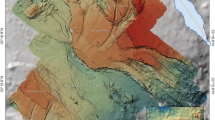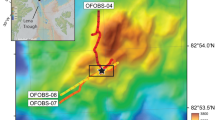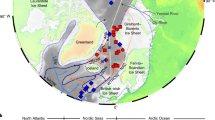Abstract
Hydrothermal circulation at the crests of mid-ocean ridges plays an important role in transferring heat from the interior of the Earth1,2,3. A consequence of this hydrothermal circulation is the formation of metallic ore bodies known as volcanic-associated massive sulphide deposits. Such deposits, preserved on land, were important sources of copper for ancient civilizations and continue to provide a significant source of base metals (for example, copper and zinc)4,5,6. Here we present results from Ocean Drilling Program Leg 169, which drilled through a massive sulphide deposit on the northern Juan de Fuca spreading centre and penetrated the hydrothermal feeder zone through which the metal-rich fluids reached the sea floor. We found that the style of feeder-zone mineralization changes with depth in response to changes in the pore pressure of the hydrothermal fluids and discovered a stratified zone of high-grade copper-rich replacement mineralization below the massive sulphide deposit. This copper-rich zone represents a type of mineralization not previously observed below sea-floor deposits, and may provide new targets for land-based mineral exploration.
This is a preview of subscription content, access via your institution
Access options
Subscribe to this journal
Receive 51 print issues and online access
$199.00 per year
only $3.90 per issue
Buy this article
- Purchase on Springer Link
- Instant access to full article PDF
Prices may be subject to local taxes which are calculated during checkout



Similar content being viewed by others
References
Wolery, T. J. & Sleep, N. H. Hydrothermal circulation and geochemical flux at mid-ocean ridges. J.Geol. 84, 249 –275 (1978).
Lister, C. R. B. in The Dynamic Environment of the Ocean Floor (eds Fanning, K. A. & Manheim, F. T.) 441–470 (Lexington Books, Lexington, (1982)).
Sleep, N. H. & Wolery, T. J. Egress of hot water from the midocean ridge hydrothermal systems: some thermal constraints. J. Geophys. Res. 96, 2375–2387 ( 1991).
Stanton, R. L. General features of the conformable “pyritic” ore-bodies. Can. Inst. Mining Metall. Trans. 63, 22– 27 (1960).
Franklin, J. M., Lydon, J. W. & Sangster, D. F. Volcanic-associated massive sulfide deposits. Econ. Geol., 75th Anniv. Vol. 485–627 (1981).
Hannington, M. D., Jonasson, I. R., Herzig, P. M. & Petersen, S. Physical and Chemical Processes of Seafloor Mineralization at Mid-ocean Ridges 115–157 (Geophys. Monogr. 91, Am. Geophys. Union, Washington DC, (1995)).
Davis, E. E. et al. Proc. ODP Init. Rep. 139, 1–1026 (1992).
Davis, E. E. & Villinger, H. Tectonic and thermal structure of the Middle Valley sedimented rift, northern Juan de Fuca Ridge. Proc. ODP Init. Rep. 139, 9–41 (1992).
Davis, E. E. & Fisher, A. T. On the nature and consequences of hydrothermal circulation in Middle Valley sedimented rift: inferences from geophysical and geochemical observations, Leg 139. Proc. ODP Sci. Res. 139, 695–717 ( 1994).
Goodfellow, W. D. & Franklin, J. M. Geology, mineralogy, and chemistry of sediment-hosted clastic massive sulfides in shallow cores, Middle Valley, northern Juan de Fuca Ridge. Econ. Geol. 88, 2037–2068 (1994).
Ames, D. E., Franklin, J. M. & Hannington, M. D. Mineralogy and geochemistry of active and inactive chimneys and massive sulfide, Middle Valley, northern Juan de Fuca Ridge: An evolving hydrothermal system. Can. Mineral. 31, 997–1024 (1993).
Krasnov, S., Stepanova, T. & Stepanov, M. Chemical composition and formation of a massive sulfide deposit, Middle Valley, northern Juan de Fuca Ridge (Site 856). Proc. ODP Sci. Res. 139, 353–372 (1994).
Duckworth, R. C., Fallick, A. E. & Rickard, E. Mineralogy and sulfur isotopic composition of the Middle Valley massive sulfide deposit, northern Juan de Fuca Ridge. Proc. ODP Sci. Res. 139, 373–385 (1994).
Fouquet, Y. et al. Middle Valley; Bent Hill area (Site 1035). Proc. ODP Init. Rep. 169(in the press).
Janecky, D. J. & Seyfried, W. E. J Formation of massive sulfide deposits on oceanic ridge crests: incremental reaction models for mixing between hydrothermal solutions and seawater. Geochim. Cosmochim. Acta 48, 2723– 2738 (1984).
Currie, R. G. & Davis, E. E. Low crustal magnetization of the Middle Valley sedimented rift inferred from sea-surface magnetic anomalies. Proc. ODP Sci. Res. 139, 19– 28 (1994).
Acknowledgements
We thank the staff of the Geological Survey of Canada, particularly J. M. Franklin and E. E. Davis, for sharing data and expertise on the Middle Valley area. We also thank the ODP Engineering staff, and the drilling, ship and scientific staff on-board the D/V JOIDES Resolution for their many contributions.
Author information
Authors and Affiliations
Corresponding author
Rights and permissions
About this article
Cite this article
Zierenberg, R., Fouquet, Y., Miller, D. et al. The deep structure of a sea-floor hydrothermal deposit. Nature 392, 485–488 (1998). https://doi.org/10.1038/33126
Received:
Accepted:
Issue Date:
DOI: https://doi.org/10.1038/33126
This article is cited by
-
Geology, mineralogy, and geochemistry of Naweoba and Bagh Cyprus-type VMS deposits of the Late Cretaceous Zhob Valley Ophiolites, Pakistan: implications for genesis
Arabian Journal of Geosciences (2023)
-
Iron isotopes constrain sub-seafloor hydrothermal processes at the Trans-Atlantic Geotraverse (TAG) active sulfide mound
Communications Earth & Environment (2022)
-
Indian Ocean Ridge System and Seafloor Hydrothermal Activity
Journal of the Geological Society of India (2022)
-
Subseafloor sulphide deposit formed by pumice replacement mineralisation
Scientific Reports (2021)
-
Crustal processes sustain Arctic abiotic gas hydrate and fluid flow systems
Scientific Reports (2020)
Comments
By submitting a comment you agree to abide by our Terms and Community Guidelines. If you find something abusive or that does not comply with our terms or guidelines please flag it as inappropriate.



